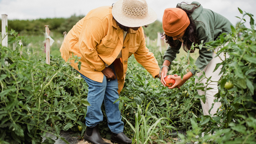
One of the best parts of homesteading is the potential to feel a little closer to the land. You’re adopting a lifestyle that prioritizes a greater understanding and respect for our natural resources. As a result, you get to embrace a mutually advantageous relationship with the world around you.
Sustainable gardening can be an important part of this. The land around your homestead can provide you with all manner of nutritious and delicious items, but you have to be responsible in how you use this invaluable resource.
Let’s dig a little deeper into sustainable gardening and look at how you can cultivate crops that boost your self-sufficiency.
The Benefits of Sustainable Gardening
Homesteading offers an alternative to the trappings of the contemporary world and provides a more authentic way of life. While you shouldn’t feel pressured to adopt every single component of homesteading, a sustainable garden is one element that offers significant benefits.
Firstly, and perhaps most obviously, you get some food out of the situation. Taking a sustainable approach enables you to not just have the occasional homegrown tomato. Rather, you gain a range of relatively consistent crops.
In addition, sustainable gardening is great for self-sufficiency and off-the-grid living. When you don’t have to depend on grocery stores for all your food, you gain much more practical and financial freedom. You’ll also be more resilient to issues like food shortages.
You’ll find that sustainable gardening includes health benefits due to the healing quality of nature. Immersion in nature is known to reduce blood pressure, lower stress and improve sleep. There can even be cognitive advantages, such as improved memory. Nature also gains from your commitment to pro-environment activities. You’ll be maintaining healthy soil and minimizing the use of harmful pesticides.
Following the Steps to Responsible Cultivation
Cultivating a garden sustainably isn’t something that you can improvise. Indeed, a lack of planning may see you produce greater waste and use more resources. This is good for neither the environment nor your homesteading lifestyle. Take a step back, get organized and use the most responsible actions.
Planning your garden
For sustainable gardening, having a green thumb is great, but being a committed planner is better. The more effectively you can plan, the more control you have over the resources you use and the crops you cultivate.
- Map out your space, with consideration to the distribution of natural light, shade and windbreakers such as trees and bushes. Mark out where to place different crops concerning their needs.
- Research the local climate throughout the year. Understanding periods of frost, heat and moisture helps you to match your planting and harvesting to the needs of each type of crop.
Preparing your soil
Your soil may not immediately be ready for a garden, so it’s important to prepare it. Perform an analysis of the pH levels, as this will help you identify whether any adjustments need to be made. If so, you can proceed with sustainable methods, such as using mushroom compost to alkalize your soil. Approach this carefully, though. You don’t want to disrupt the soil balance of other plants in the area.
Plant Diversely
When it comes time to plant your crops, the most sustainable approach is to aim for diversity. Simply having the same types of plants with the same needs sharing space all the time can put too much pressure on the land. A more sustainable approach favors different crops not just concurrently but rotated throughout the year. Don’t exhaust your land.
Water responsibly
Efficiency is key when it comes to watering a sustainable garden. Drip irrigation systems — in which a network of tubes slowly drip-feed water to your crops — can be a good start. However, you should also use responsible water recycling practices, such as rainwater collection or reusing greywater from showers or baths.
Heading to Market
Your sustainable gardening journey isn’t just good for your family. It can also help you to forge relationships with your local community that are personally, culturally and financially rewarding.
Perhaps the most practical way to do this is by shifting your hobby garden toward a permaculture market garden. This involves using permaculture — the practice of working with nature rather than bending the ecosystem to meet your needs — to cultivate crops for the wider community. It’s generally more sustainable because you’ll be planting your crops in ways that are less dependent on human intervention, instead replicating how plants grow as part of a natural ecosystem. This results in a more balanced use of resources.
So, why grow enough of these foods to take to local farmers’ markets or trade with nearby independent stores? Well, it’s not just an opportunity for you to make a little extra cash. Your garden can support better local food security, as the community will be less reliant on mass-market supply chains that could be subject to disruptions. From an emotional perspective, you’ll also have positive and meaningful interactions with your neighbors as you influence their well-being.
Conclusion
Sustainable gardening is an environmentally responsible way to boost your homesteading self-sufficiency. You benefit from relatively reliable food sources and the health advantages of interacting with nature. That said, it’s important to take a mindful and well-planned approach. This helps to ensure you’re making choices that are in line with the needs of the ecosystem. If you want to take things a step further, transforming your personal garden into a permaculture market garden can help you support your wider community.
The main thing to remember about all these activities is that you should be led by the needs of the nature that surrounds you. By not acting in ways that exhaust or manipulate the ecosystem, you can more fully enjoy the advantages of a garden.










